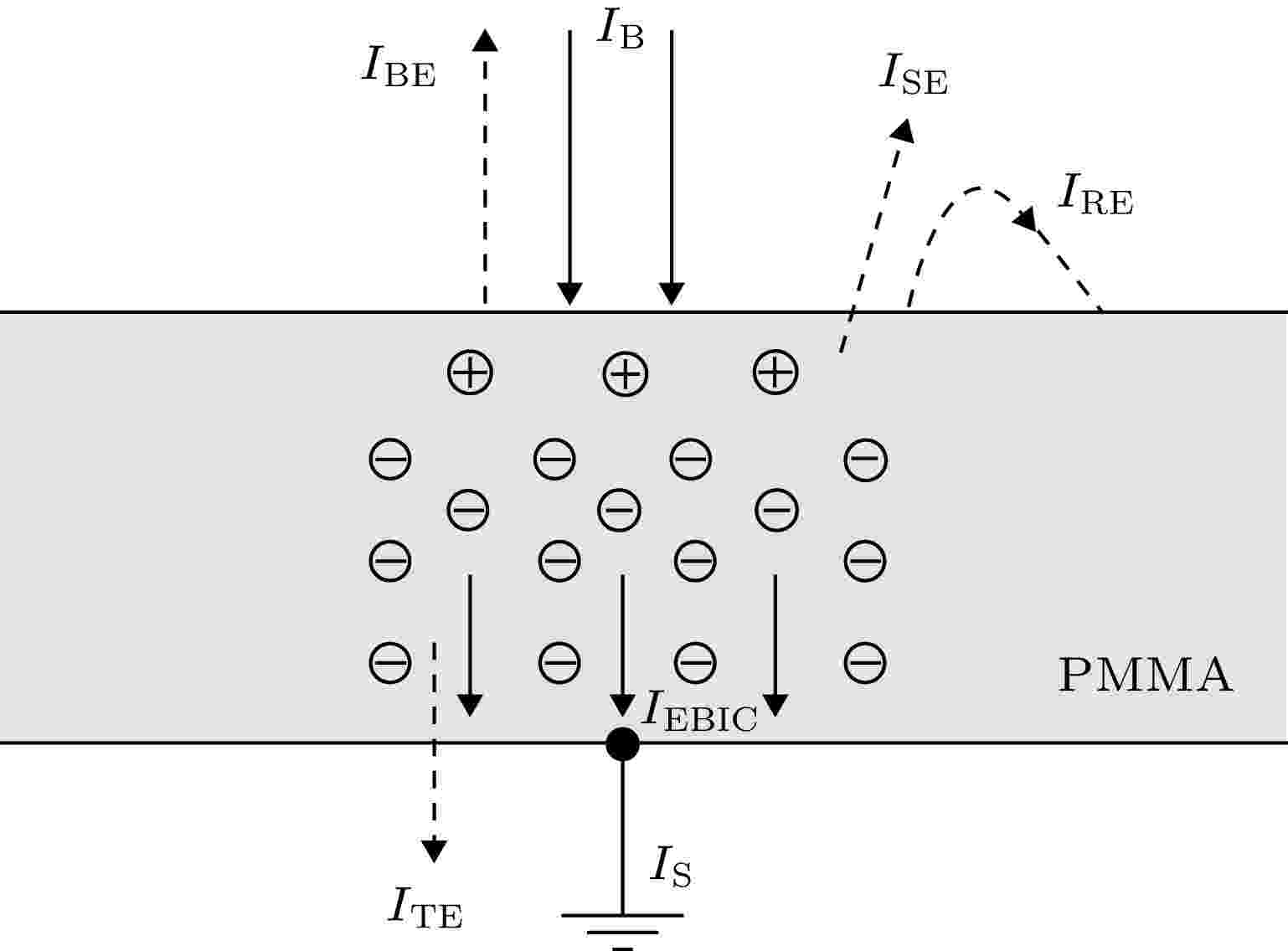全文HTML
--> --> -->当高能电子照射薄膜时, 入射电子与样品原子发生碰撞激发出电子空穴对, 激发电荷在样品内部经历复杂的碰撞、输运、复合和俘获过程. 出射和入射电子的不平衡也导致样品内部沉积电荷. 近年来的理论分析、数值计算及实验测量结果均表明, 这种辐照引起的电荷分布及相关的出射电子电流、透射电流等是影响成像质量和检测精度的关键问题[9-12].
高能透射电子照射聚合物薄膜时, 其电子总产额远小于1, 经非弹性散射激发的部分次级电子会沉积在样品内部形成空间电荷分布, 产生的静电场也会影响入射电子的运动轨迹、内部电荷的输运以及透射电子的方向[13-15]. 由于样品内空间电荷分布取决于迁移、扩散、俘获、复合等过程, 因而呈现动态变化特性, 实验难以准确测量, 其定量研究比较缺乏[16]. 更重要的是, 薄膜样品的表面电场还可能影响二次电子的出射及返回特性, 最终影响出射电子电流[17], 其发展机理尚不明确. 以往研究中, 建立了考虑电子散射、俘获和输运的二维数值模型, 获得了高能电子束照射下电介质厚样品的表面电位和泄漏电流特性[18-20].
本文以聚甲基丙烯酸甲酯(PMMA)为例, 建立了较为完善的数值计算模型, 研究了能量大于10 kV的高能透射电子束照射下聚合物薄膜的带电特性. 对于电子的散射过程, 建立了基于Rutherford弹性散射和Penn介电函数的Monte Carlo (MC)模型; 对于样品内部电荷的运动过程, 建立了考虑输运、俘获及复合的有限差分法计算模型. 阐明了聚合物薄膜空间电荷、空间电场以及出射电子电流、样品电流及透射电流的动态演变规律; 揭示了相关的样品及电子束参数对带电特性的影响.
图1是高能透射电子与聚合物薄膜相互作用示意图. 首先, 电流大小为IB的高能电子束照射聚合物, 少量入射电子直接被样品反射形成背散射电子电流IBE. 经非弹性散射生成的部分次级电子脱离表面形成二次电子电流ISE. 对于聚合物薄膜, 部分入射电子会穿透样品形成透射电子电流ITE. 此外, 样品内部沉积电子经输运可能到达基板形成电子束感生电流IEBIC; 在表面电场作用下, 部分出射二次电子可能返回表面形成返回电流IRE, 最终沿表面输运形成样品电流, 上述IEBIC和IRE统称为样品电流IS.
 图 1 高能电子与PMMA薄膜相互作用示意图
图 1 高能电子与PMMA薄膜相互作用示意图Figure1. Interaction between high-energy electrons and PMMA thin film.
2
2.1.电子散射过程
选取高于10 keV的电子束, 采用Rutherford弹性散射模型描述弹性散射过程, 以Penn介电函数模型和快二次电子模型描述非弹性散射过程. 高能电子照射样品后, 与样品原子或分子发生复杂的散射过程. 入射电子与样品原子碰撞时, 或者受原子核库仑电场的作用发生大角度弹性散射, 或与原子的核外电子发生碰撞使原子受到激发发生非弹性散射. 这里, 高能电子与分子、原子的散射实质是电子的近场跳跃, 即电子的非弹性散射主要与价电子激发相关, 与PMMA的密度密切相关.Rutherford弹性散射模型是研究高能电子束与电介质相互作用的常用方法, 也可用于PMMA聚合物的近似计算[21-24]. 对于入射能量大于10 keV的高能电子弹性散射过程, 在Born近似下, 可通过求解Schrodinger方程得到Rutherford弹性散射截面[25]:




非弹性散射使入射电子能量损失, 但角度的变化比弹性散射导致的损失要小. 一个入射电子在整个非弹性散射过程中, 会激发出大量电子空穴对. 当入射电子能量大于10 keV时, 采用快二次电子模型来描述, 其微分散射截面为









当非弹性散射使得入射电子能量小于3 keV时, 采用Penn介电函数来描述其后续非弹性散射过程[26,27]. 根据介电函数理论, 其非弹性散射微分平均自由程为











2
2.2.电子俘获和输运
经过散射能量耗尽的电子会被样品的陷阱俘获或者在样品内部输运. 本研究采用基于Poole-Frenkel效应的俘获截面模型[28]. 这里, 电子密度随时间t变化的微分形式如下:

电荷在材料中的输运特性是微纳电子器件研究的重要方面[29]. 本研究中的输运特性基于内部电场下的迁移和密度梯度作用的扩散模型. 对于三维直角坐标系统, 电荷的输运满足电流连续性方程:




由于空穴迁移率远小于电子迁移率, 因此假定空穴保持静止. 自由电子与空穴有可能复合, 直接复合是由电子在导带和价带之间的直接跃迁形成的, 计算式为
对微分方程组(9)—(13)式采用有限差分法求解. 在有限差分法计算中, 电子束照射前, 空间电位、电荷密度的初始赋值均为零. 差分网格的大小尽管对最终结果影响不大, 但会影响计算速度. 为了兼顾计算速度和准确性, 差分网格大小取5 nm.
2
2.3.出射电子电流计算模型
在计算二次电子电流和背散射电子电流时, 由于表面电场的影响, 部分能量较低的出射电子可能会返回表面并形成样品电流. 根据表面上方空间电场, 可计算得到出射电子电流. 对于三维坐标系统(x, y, z), z方向为入射方向, 在(12)式的空间电位得到空间电场Fx, Fy和Fz分量的基础上, 出射电子的运动方程为








2
2.4.数值计算流程
高能透射电子束照射下诱导产生的带电效应及流出电流是一个动态变化过程. 图2给出了在高能电子束持续照射下带电效应的模拟流程, 具体如下. 图 2 计算流程示意图
图 2 计算流程示意图Figure2. Flow diagram of the charging process.
1) 初始化. 把样品内部的空间电荷密度、空间电位初始化为零.
2) 计算单电子散射过程. 模拟一个电子的弹性散射和非弹性散射过程, 获得样品内部沉积电子、空穴、空间电位的初始分布以及出射电子的位置、能量和角度等信息.
3) 计算电荷的输运和俘获过程. 根据空间电荷、空间电位的初始分布计算电子在样品内部的迁移、扩散及俘获; 计算电子束感生电流.
4) 计算出射电子电流. 由空间电位分布计算空间电场分布, 计算出射背散射电子和二次电子的出射轨迹, 获得出射电子电流和返回电子电流.
5) 计算透射电子电流. 由入射电子的散射过程, 获得透射电子电流.
6) 在前一个入射电子的空间电荷、空间电位的基础上, 计算下一个入射电子的整个入射过程, 最后直至所有的入射电子计算完毕.

| 参数 | 取值 | 单位 |
| 电子束能量EB | 10 | keV |
| 束流 | 0.16 | pA |
| 样品厚度H | 2 | μm |
| 复合率 | 10–14 | cm–3·s–1 |
| 电子迁移率μ | 10–10 | cm2·V–1·s–1 |
| 陷阱体密度Ntrap | 1017 | cm–3 |
表1参数默认取值
Table1.Default values of parameters.
2
3.1.空间电荷及电场分布
衡量样品带电强弱的一个重要指标是电子产额, 其定义为从表面出射电子个数与入射电子个数之比. 图3是模拟得到的电子总产额
 图 3 电子总产额的模拟(线条)和测量(方块)结果
图 3 电子总产额的模拟(线条)和测量(方块)结果Figure3. Simulated (lines) and experimental (squares) electron total yields.
对于本文研究的薄膜样品, 影响其内部电荷沉积的还包括透射电子的数目. 影响透射电子数目的主要因素是电子束的入射深度λ, 它主要取决于电子束能量和样品材料密度, 其经验公式为[25]
高能电子束照射下, 样品内部电荷的分布是一个动态变化过程. 图4是不同照射时刻, 样品中心自由电子密度N0,0,z(t)和净电荷密度C0,0,z(t)沿入射方向(z方向)的分布. 这里净电荷密度是一个网格点空穴密度与电子密度之差. 首先, 由于近表面附近经非弹性散射激发的次级电子从样品出射, 因而近表面附近自由电子密度较低; 而在样品靠近基底区域(z = 2 μm), 一方面非弹性碰撞激发的次级电子数目减少, 且由于电子的输运导致该区域自由电子密度也较低. 随着电子束的照射, 这样的分布形态更加明显. 如图4(b)所示, 净电荷密度在深度小于0.1 μm区域内为正, 而在下方为负. 其原因主要是近表面二次电子的出射. 此外, 随着电子束照射, 样品内沉积更多电荷, 净电荷密度将逐渐升高. 但在长时间照射下, 沉积电子在内建电场的作用下向表面输运, 反而降低了表面净电荷密度, 因此净电荷密度将趋于一个稳定值.
 图 4 样品内部入射方向电荷分布 (a) 电子密度; (b) 净电荷密度
图 4 样品内部入射方向电荷分布 (a) 电子密度; (b) 净电荷密度Figure4. Charges distribution along the incident direction: (a) Electron density ; (b) net charge density.
图5是不同照射时间空间下电位V0,0,z(t)和电场强度E0,0,z(t)沿入射方向的分布. 从图5(a)可知, 在样品近表面, 空间电位为正, 然后沿入射方向下降至一个极小值, 最后逐渐上升趋近于零. 这里, 虽然整体上样品带负电, 但由于净电荷密度在近表面为正, 所以样品近表面空间电位为正. 此外, 随着电子束照射, 近表面正电位持续升高, 同时空间电位极小值也持续下降, 这主要是随着照射, 净静电荷密度持续升高所致(图4(b)). 最后, 如图4(b)所示, 空间电场的分布形态决定了样品内部电荷的输运方向. 一方面, 在样品内部1 μm上方电场强度为负, 吸引电子向表面输运, 减缓了表面正电位的升高趋势; 而在1 μm下方电场强度为正, 推动电子向基底输运, 形成电子束感生电流及样品电流.
 图 5 (a) 空间电位; (b) 电场强度沿入射方向分布
图 5 (a) 空间电位; (b) 电场强度沿入射方向分布Figure5. (a) Space potential and (b) electric field along the incident direction.
2
3.2.出射及透射电子电流
从图4可知, 由于高能电子束可穿透聚合物薄膜, 尽管电子产额远小于1, 但其带电强度较弱. 图5所示的表面正电位还会吸引一些出射二次电子返回表面, 从而降低了实际的出射电子电流.图6是表面电位VS和出射电子电流Iσ的时变特性模拟结果. 首先, 随着电子束照射, 表面正电位持续升高并趋于稳定值. 这是表面正空间电荷持续升高所致. 此外, 随着电子束照射, Iσ逐渐下降. 事实上, 随着表面电位的升高, 会引起更多的二次电子返回表面, 导致实际的出射电子电流降低.
 图 6 表面电位VS和出射电子电流Iσ时变特性
图 6 表面电位VS和出射电子电流Iσ时变特性Figure6. The surface potential VS and emission current Iσ as function of time.
图7是透射电流ITE和样品电流IS的时变特性. 从图7可以看出, 透射电流基本上保持恒定. 事实上, 对于聚合物薄膜, 由于样品表面和内部电场强度均较弱, 入射电子在散射过程中的运动方向及能量衰减受其影响较小, 因而透射电流的变化较小. 此外, 就样品电流IS而言, 一方面随着电子束照射, 电子束感生电流逐渐增大; 同时由于表面正电位的升高, 更多二次电子返回表面流经基底形成样品电流. 因此总体上样品电流增大.
 图 7 透射电流ITE和样品电流IS时变特性
图 7 透射电流ITE和样品电流IS时变特性Figure7. The transmission current ITE and the sample current IS as function of time.
下面分析上述流出薄膜的电流稳态特性. 在电子束照射下, 随表面电位升高, 返回样品表面的电子电流逐渐增大, 但返回表面的电子会降低表面正电位. 此外, 随内部电场的增强, 电子束感生电流增大; 但电子束感生电流的增大, 反过来又会减弱内部电场强度. 最终流入流出样品的电流达到稳定, 也就是


2
3.3.参数的影响
33.3.1.薄膜厚度
薄膜厚度的增加使得样品内的沉积电荷量增加. 图8是不同厚度下表面电位和电流的时间特性. 如图8(a)所示, 随样品厚度的增加, 更多的电荷将沉积在样品内部, 因此表面电位将下降, 带电过程的瞬态时间也更长. 同时, 表面电位的下降使得更少的二次电子返回表面, 实际出射的电子电流
 图 8 不同厚度下的带电特性 (a) 表面电位; (b) 表面出射电流; (c) 样品电流; (d) 透射电流
图 8 不同厚度下的带电特性 (a) 表面电位; (b) 表面出射电流; (c) 样品电流; (d) 透射电流Figure8. Charging characteristics under different thicknesses: (a) Surface potential; (b) surface emission current; (c) sample current; (d) transmission current.
需要指出的是, 对于聚合物体样品或电子束非穿透厚样品, 在高能电子束照射下, 由于没有透射电流且内部电子难以通过基底泄放, 其内部将沉积大量负电荷, 因而其表面电位往往可低至负千伏量级, 严重时可导致样品被击穿[36]. 表面负电位可使入射电子着陆能量大幅下降, 其二次电子电流明显升高, 而样品电流及透射电流几乎为零. 这与本文研究的薄膜样品相关结论有本质不同.
3
3.3.2.入射能量
下面分析电子束入射能量对带电过程及相关电流的影响. 图9给出了不同能量下表面电位及各类电流的时变特性. 事实上, 入射能量的升高使电子束的入射深度更大, 从而电子产额下降. 首先, 由于电子散射范围的增大, 沉积电子分布在更广泛的区域, 样品内部的负带电强度减弱, 使得表面电位下降, 但较小的输运距离使电子输运到基地的瞬态时间减小(图9(a)). 表面电位的下降使得返回表面的二次电子数目减小, 实际的出射电子电流减小(图9(b)). 此外, 由于样品内部的负带电强度较弱, 因而电子束感生电流及样品电流随入射能量的升高而减小(图9(c)). 最后, 入射能量的升高使透射电流明显升高; 由于样品带电强度较弱, 透射电流不随时间发生明显变化(图9(d)). 图 9 不同入射能量下带电特性 (a) 表面电位; (b) 表面出射电流; (c) 样品电流; (d) 透射电流
图 9 不同入射能量下带电特性 (a) 表面电位; (b) 表面出射电流; (c) 样品电流; (d) 透射电流Figure9. Charging characteristics under different beam energies: (a) Surface potential; (b) surface emission current; (c) sample current; (d) transmission current.
聚合物样品的电子迁移率往往非常低, 导致样品近表面电位为正, 而内部电位为负. 相反, 对于电子迁移率较高的半导体样品及电介质样品, 虽然入射电子束能量较高, 但较高的电子迁移率使得次级电子较易输运到基底形成样品电流, 因而样品内部带电强度非常弱, 故其出射电子电流、样品电流的时间特性应该与本文结果有较大区别.
样品的陷阱密度也会影响相关的带电及流出电流特性. 陷阱密度越大, 单位时间样品内可自由流动的自由电子数量越小, 使得电子输运到基底的时间变长, 因而带电瞬态时间变长, 相应的表面电位下降. 但陷阱密度的变化不改变样品内部带电及流出样品电流产生的物理机理, 因而其随时间变化的趋势并不会发生改变.
1) 在高能电子束的照射下, 由于表面及近表面电子的出射, 净电荷呈现为表面正, 内部为负的分布特性, 因而空间电位呈现出在表面、近表面为正, 内部为负的分布特性; 这种形态决定了部分出射二次电子可返回表面, 而内部沉积电子向基底输运形成电子束感生电流的现象.
2) 随着电子束照射, 样品表面正电位逐渐上升并趋于一个稳定值, 而实际的表面出射电流逐渐下降至一个稳定值, 样品电流逐渐升高至一个稳定值; 由于薄膜带电强度整体较弱, 透射电流不随时间变化.
3) 薄膜厚度的增加使带电过程的瞬态时间增长, 样品内部带电强度增大, 因而表面电位逐渐下降, 实际出射电子电流增加; 内部电场强度的增大导致样品电流增大.
4) 电子束能量的升高降低了电子产额, 导致表面正电位下降, 从而实际出射电子电流减小. 透射电流随电子束能量的升高而增大, 又因样品带电强度的减弱, 样品电流减小.
本文以PMMA薄膜为对象研究了单层聚合物薄膜的带电效应, 但得到的相关结论同样适用于其他低迁移率的聚合物样品. 此外, 实际中的样品可能会包含有内部结构, 其内部电荷积累、输运及俘获过程更为复杂, 因而有必要进一步开展相关的研究工作.
